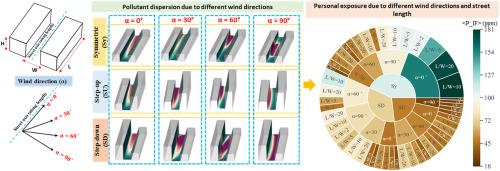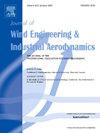风向和街道长度对理想街道峡谷中污染物扩散和行人暴露的综合影响:CFD方法
IF 4.9
2区 工程技术
Q1 ENGINEERING, CIVIL
Journal of Wind Engineering and Industrial Aerodynamics
Pub Date : 2025-10-03
DOI:10.1016/j.jweia.2025.106247
引用次数: 0
摘要
本研究在数值上考察了风向和街道长度对城市街道峡谷中污染物扩散、通风和行人暴露水平的综合影响。在4种风向(α = 0°、30°、60°、90°)下,分析了宽高比(AR = 1、3)和街道长度(L/W = 2-20)下的理想对称、升压和降压峡谷形态。采用无因次空气交换率(ACH∗)和行人净逃逸速度(neped∗)评估通风性能,并通过进气分数(<P_IF>)量化暴露程度。结果表明,在平行风(α = 0°)下,对称峡谷的污染物浓度最高,而在斜风和垂直风下,升压峡谷和降压峡谷的污染物浓度最高。在斜风(α = 30°~ 60°)和垂直风(α = 90°)下,对称峡谷和降压峡谷的通风效率最高。最低的<;P_IF>;分别出现在对称、降压和升压峡谷的斜风、平行风和垂直风下。较长的街道通常会减少通风,增加<;P_IF>,特别是在α = 0°时。然而,AR = 3的降压峡谷在α = 30°-90°时,L/W >; 10的通风效果更好。这些发现为优化峡谷几何形状以提高城市空气质量提供了实用的见解。本文章由计算机程序翻译,如有差异,请以英文原文为准。

Integrated influence of wind direction and street length on pollutant dispersion and pedestrian exposure in idealized street canyons: A CFD approach
This study numerically examines the combined effects of wind direction and street length on pollutant dispersion, ventilation, and pedestrian-level exposure in urban street canyons. Idealized symmetric, step-up, and step-down canyon configurations with aspect ratios (AR = 1, 3) and street lengths (L/W = 2–20) were analyzed under four wind directions (α = 0°, 30°, 60°, 90°). Ventilation performance was evaluated using dimensionless air exchange rate (ACH∗) and pedestrian net escape velocity (NEVped∗), while exposure was quantified through intake fraction (<P_IF>). Results show that symmetric canyons accumulate the highest pollutant concentrations under parallel winds (α = 0°), while step-up and step-down canyons show peak levels under oblique and perpendicular winds, respectively. Ventilation efficiency is highest in symmetric and step-down canyons under oblique winds (α = 30°–60°), and in step-up canyons under perpendicular winds (α = 90°). The lowest <P_IF> occurs under oblique, parallel, and perpendicular winds for symmetric, step-down, and step-up canyons, respectively. Longer streets generally reduce ventilation and increase <P_IF>, particularly under α = 0°. However, step-down canyons with AR = 3 demonstrate improved ventilation for L/W > 10 under α = 30°–90°. These findings offer practical insights for optimizing canyon geometries to enhance urban air quality.
求助全文
通过发布文献求助,成功后即可免费获取论文全文。
去求助
来源期刊
CiteScore
8.90
自引率
22.90%
发文量
306
审稿时长
4.4 months
期刊介绍:
The objective of the journal is to provide a means for the publication and interchange of information, on an international basis, on all those aspects of wind engineering that are included in the activities of the International Association for Wind Engineering http://www.iawe.org/. These are: social and economic impact of wind effects; wind characteristics and structure, local wind environments, wind loads and structural response, diffusion, pollutant dispersion and matter transport, wind effects on building heat loss and ventilation, wind effects on transport systems, aerodynamic aspects of wind energy generation, and codification of wind effects.
Papers on these subjects describing full-scale measurements, wind-tunnel simulation studies, computational or theoretical methods are published, as well as papers dealing with the development of techniques and apparatus for wind engineering experiments.

 求助内容:
求助内容: 应助结果提醒方式:
应助结果提醒方式:


